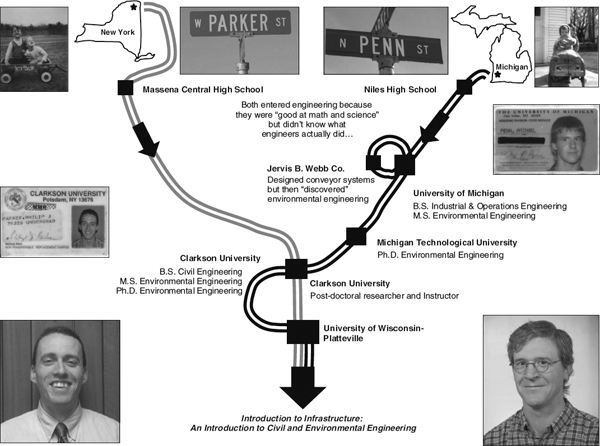About the Authors
Mike and Philip met and quickly became friends at Clarkson University in 1994. Since 1998 they have been teaching courses and sharing ideas at the University of Wisconsin-Platteville. They were drawn to, and have remained at UW-Platteville, due to its focus on undergraduate education and the dedication of their colleagues. The Civil and Environmental Engineering (CEE) Department at UW-Platteville offers degrees in both civil and environmental engineering, with substantial overlap between the curricula. Students and faculty in both programs interact on a daily basis, and in fact it is often difficult to distinguish between students of the two programs. Both programs are heavily application based, with a focus on consulting engineering. The authors, and the vast majority of CEE faculty, are registered Professional Engineers. While Mike and Philip are active in research and consulting, their primary motivation comes from their daily interactions with undergraduates. They have had countless discussions about how students learn, how to improve teaching, and what students should learn.
In 2001, Mike began working with the Wisconsin Section of the American Society of Civil Engineers (ASCE) to co-author the first version of Wisconsin's Infrastructure Report Card. This project truly opened his eyes to the vastness, complexity, and importance of infrastructure. Soon thereafter, a vision was developed for an Introduction to Infrastructure course. Attending the Infrastructure Solutions Summit hosted by ASCE and touring the damage caused by Hurricane Katrina provided further inspiration. Serving on the local Water and Sewer Commission provided first-hand experience with many of the infrastructure challenges that are commonly faced across the country. A few years later, the UW-Platteville CEE Department was awarded a grant from the National Science Foundation to develop an introductory infrastructure course. The department faculty and practicing engineers developed a framework for the course, which largely serves as the table of contents for this textbook.
As a result of these efforts, an Introduction to Infrastructure course is now offered. Initial offerings of this course have received rave reviews. One sophomore that completed the course told Philip: “To be honest, before I took this course I didn't really have any idea what civil engineering was all about.” Another student, caught in what he termed the “death march” of calculus, science, and engineering fundamentals courses, said after completing the course: “At the start of this semester, I was planning on dropping civil engineering and getting a [non-engineering] degree in construction management. But after taking this course, I am motivated to continue my degree.” Such comments are especially gratifying as they agree with the authors' predictions about the potential impact of the course.
Philip and Mike have distinct but similar teaching styles, both focusing on student comprehension and student engagement. They are both frustrated by traditional engineering education that seems to focus on how to design components rather than understanding how the components fit into a system or, perhaps more importantly, why the component is even needed. Over the years, their courses have increasingly incorporated non-technical content including economics, public perception, risk management, and politics. This shift is not based solely on their personal preferences; rather, employers of UW-Platteville CEE graduates, with whom they continuously communicate, have indicated that student awareness of the non-technical aspects of infrastructure is more important now than ever.
They are passionate about teaching as well as assessing what students actually learn. Some lessons that they have learned about teaching include:
- Students enjoy learning about the non-technical realities of engineering
- Many students do not have the experience to see how all the pieces fit together
- Helping students develop a broader perspective favors deep learning rather than memorization
- Students respond favorably to practical applications of their coursework
- Just because students are pursuing a degree in civil or environmental engineering does not imply that they understand, or are even aware of, the civil infrastructure that supports their lives
- Repetition is a key to increased student learning
- The true measure of success is the knowledge that students retain after completion of a course.
They have distilled their understanding of, and passion for, infrastructure into a format that will introduce students to the fields of civil and environmental engineering. As a result of using this textbook, they hope that students become much more aware of the infrastructure surrounding them, more appreciative of its complexity, more understanding of its importance to our national and economic security, and inspired to continue their studies in civil and environmental engineering.

